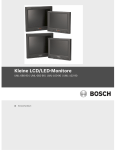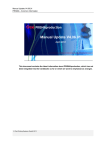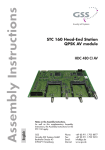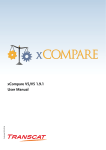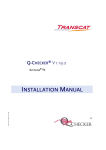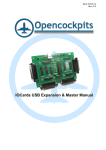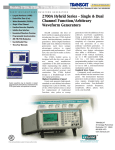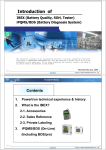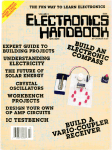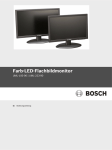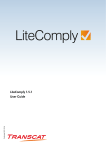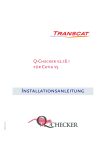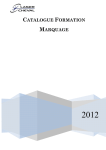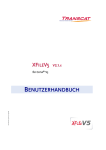Download SPIEGEL - Transcat PLM
Transcript
CATIA ® Software SPIEGEL User manual SPIEGEL 1 General 1.1 Norms 3 1.1.1 ECE-R 46 Norm 4 1.1.2 US – Norm FMVSS111 6 1.2 Position of the Vehicle and the Mirror 7 1.2.1 Mirror Plane and Mirror Coordinatesystem 7 1.2.2 Angle 9 1.2.3 Mirror Surface 1.3 10 Display in CATIA 11 1.3.1 3D Display 11 1.3.2 Views in CATIA 12 2 Instruction Manual 13 2.1 The MIRROR-Program for CATIA ® from TransCAT 13 2.2 Starting the Program 14 2.2.1 Data 14 2.2.2 Design/Display Contours 19 2.2.3 Viewing the Mirror Surface 21 2.2.4 Adjusting the Mirrors 24 2.2.5 Calculate Occultation 25 3 3.1 Appendix 29 Troubleshooting © TransCAT GmbH & Co. KG 29 2 CATIA Software SPIEGEL 1 General The Spiegel-Program calculates the field of view with interior and exterior mirrors, with the goal to design mirrors that meet the requirements of not only the ECE-R 46 Norm, (for automobiles as well as trucks), but also fulfill the conditions of the USNorm FMVSS111. 1.1 Norms Within the respective Norms the legislator prescribes the particular area at the rear of the vehicle that has to be visible through each mirror. The texts of the Norms refer to fields on the tracks that are limited by the horizon at their rears, (exceptions to this are wide angle mirrors on trucks, and ground mirrors). However this procedure is not feasible for practical and mathematical trials. This is why the TÜV (German Safety Standards Authority) examines and measures the driver’s percentile eye range on a vertical screen. The trial process conducted by the TÜV runs as following: - Dot-shaped sources of light represent the points of the driver’s eyes. - A mirror projects the beams of light onto a vertical screen at the rear of the vehicle. - There is a rectangular regulatory area marked on the screen that has to be illuminated. The program simulates this process that can be very costly. With the aide of this program, the user can easily test how certain parameters effect the degree of illumination. In this case, the program differentiates between the automobile Norm ECE-Screen and ECE-Road, as well as US-Screen and US-Road. The TÜV trials are simulated during the Screen-Norms, and the driver’s percentile eye range within the regulatory area can be calculated. The Road-Norms simulate the driver’s eye range on the track, and the contours deriving from the driver’s eye range can be calculated, however without percentile details. Amongst other things, the Norms determine, where the points of the driver’s eyes lie, the distance between the regulatory area and the vehicle, and the size of the regulatory field on the screen and on the tracks respectively. © TransCAT GmbH & Co. KG 3 CATIA Software SPIEGEL Refer to the Norm-texts concerning the minimum mirror size and the required degree of illumination. The data used by the program is described as following: 1.1.1 ECE-R 46 Norm The location of the point of the eyes in the ECE-Norm is defined by the location of the seating-reference-point and the position of the vehicle on the track (e.g. by spring-deflection). 1.1.1.1 Passenger Vehicles The location and the size of the regulatory field on the screen can be derived by the following table: Type of Mirror Interior Mirror Exterior Mirror Driver side Exterior Mirror Passenger side Position Size 60 m behind Height: upper mirror point above the the point of the lane eyes. Width: from 10 m to the left of, up to 10 m to the right of the center of the vehicle 10 m behind Height: upper mirror point above the the points of track the eyes Width: 2.5 m beyond the point of the vehicle’s point of greatest width 20 m behind Height: upper mirror point above the the points of lane the eyes Width: 4 m beyond the vehicle’s point of greatest width The height of the field is re-calculated when adjustments are made to the mirrors. (upper mirror point above the lane). While height can be ignored, the position of the regulatory field on the track is identical in width and location. 1.1.1.2 Trucks Displays of the eye range for the ECE-Truck Norm solely take place in designated space-areas. The regulatory areas in use,are similar to those used by DaimlerChrysler AG. © TransCAT GmbH & Co. KG 4 CATIA Software SPIEGEL Type Exterior Mirror Driver Side Position 10 m behind the points of the eyes Main Mirror Passenger Side 4 m behind the points of the eyes Wide Angle Mirror Passenger Side 3 m behind the points of the eyes Ground Mrror Passenger Side Forwards Limitation:Depends upon the forward most point of the vehicle. The vertical plane limits the field to the front, and lies 1 m in front of the points of the eyes. If the vertical plane lies closer than 1 m in front of the points of the eyes, then this plane is considered. © TransCAT GmbH & Co. KG 5 Size Height: upper mirror point above the track Width: 2.5 m beyond the vehicle’s point of greatest width Height : The field is „folded“ at a distance of 30 m, the height corresponds to the upper most mirror point above the track Width: At 4 m, the width of the field is 0.75 m, if measured from the vehicle’s point of greatest width. The field widens in linear progression until it reaches a distance of 30 m behind the points of the eyes and a width of 3.5 m Height: The field is limited at a distance of 25 m behind the points of the eyes and lies on the track. Width: Measuring from the point of the vehicle’s greatest width, the width of the field is 2.5 m. The field widens in linear progression until it reaches a distance of 15 m behind the points of the eyes and a width of 12.5 m. The fied lies on the track. Width: Add 0.2 m to the greatest width of the driver’s cab, and 1 m beyond that point. CATIA Software SPIEGEL 1.1.2 US – Norm FMVSS111 The Position of the points of the eyes in the US-Norm FMVSS111 depends upon the seating-reference-point, the position of the vehicle on the track (spring deflection) and two more parameters, namely the so-called H-Point-Travel and the Torso-Line, or the degree at which the driver is “leaning” into the seat. These parameters have been standardized at the following values: - H-Point-Travel: 165 mm (inconvenient seat position) Torso-Line: 25 degrees Depending on the position of the mirror, it is presumed that a driver will turn his/her head, and the points of the eyes will no longer be parallel to the vehicle’s axles. The points of the eyes are re-calculated with each adjustment made to the mirrors in the program, therefore a head turning can occur, if the given angle described in the Norm is exceeded. The calculation of the points of the eyes in the US-Norm corresponds to the trials that the DaimlerChrysler AG conducts. © TransCAT GmbH & Co. KG 6 CATIA Software SPIEGEL The location and size of the regulatory area can be derived from the following table: Type of Mirror Interiror Mirror Position 61 m behind the backward most point of the vehicle Exterior Mirror 10.7 m behind Driver’s Side the middle point of the eyes Exterior Mirror 10.7 m behind Passenger’s Side the middle point of the eyes Size Height: upper mirror point above the track Width: Is calculated according to the mirror’s positon to the points of the eyes Height: upper mirror point above the track Width: 2.44 m beyond the point of the vehicle’s greates width Height: upper mirror point above the track Width: 2.44 m beyond the point of the vehicle’s greates width The height of the field is re-calculated when adjustments are made to the mirrors. (upper mirror point above the lane). While height can be ignored, the position of the regulatory area on the track is identical in width and location. 1.2 Position of the Vehicle and the Mirror The following data describes the mirrors: - planar or spherical Contour in the actual CATIA-model - The point of rotation of the mirror - The mirror’s distance to the point of rotation - Parameters that define the shape of the glass (for spherical and aspherical mirrors) Additionally the Norm requires certain data about the vehicle, which must be given, such as the width of the vehicle, as well as data that reveals the position of the vehicle on the track. -> go to Chapter Instruction Manual Data. The reference-axis-system (vehicle-coordinating-system) of the Program is the CATIA-Axissystem *AXS1 of the current model. The x-axis must be running opposite the driving direction, with the z-axis pointing upwards. see Figure fig.2 © TransCAT GmbH & Co. KG 7 CATIA Software SPIEGEL 1.2.1 Mirror Plane and Mirror-Coordinate-System In the case of a spherical, or aspherical mirror, the mirror plane is the tangent plane on the mirror at the point at which the mirror’s surface and the mirror’s center of rotation would meet At the zero-position, the xy-plane of the mirror-coordinate-system is parallel to the yz-plane of the vehicle-coordinate-system. The source of the mirror-coordinating system is the point at which the mirror’s center of rotation and the mirror plane would connect. The plane at zero-position is parallel to the xy-plane of the vehicle-coordinatesystem for groundmirrors on trucks. -> see Figure fig.1 Fig. 1 Position of the Mirror’s Center of Rotation © TransCAT GmbH & Co. KG 8 CATIA Software SPIEGEL Fig. 2 Position of Mirror- and Vehiclecoordinatesystem 1.2.2 Angle The two adjusting angles of the mirrors are: - vertical: Rotation around the fixed y-axis of the mirror-coordinate-system (i. e. the z-axis of the vehicle-coordinate-system). - horizontal: Rotation around the x-axis of the mirror-coordinate-system that does not remain in a fixed position. © TransCAT GmbH & Co. KG 9 CATIA Software SPIEGEL According to the mathematical sense of rotation, the angles have a prefixed sign. E. g., if an exterior driver’s side mirror is turned toward the driver in a vehicle with the steering wheel on the left, then the value of the vertical angle will be positive. The vertical angle of the passenger’s side mirror decreases, if the mirror is turned towards the driver. The following angle definitions have been used in the program: Absolute Angle Rotation of the mirror to the absolute zero-point of the mirror-coordinatesystem (mirror plane is parallel to the yzplane of the vehicle-coordinate-system). Initial Situation The zero-position for the mirror’s suspension can be set here Relative Angle to the Initial Situation Rotation of the mirror towards initial situation -> angles need not be converted, so the adjustment range for the mirror’s joint can be determined 1.2.3 Mirror Surface The program handles planar, spherical and aspherical mirrors. Planar The mirror surface is identical to the xyplane of the mirror-coordinate-system. Spherical The mirror surface is finitely determined via a radius. The tangent point of the sphere and the xy-plane is identical to the source of the mirror-coordinatesystem. The following are needed to determine the mirror surface: - Radius - Parameter for Glas - Parameter position of mirrorcoordinate-system Aspherical (-> see Figure fig. 3) © TransCAT GmbH & Co. KG 10 CATIA Software SPIEGEL Fig. 3 Aspherical Mirror, Intersection Mirrorglass The contour of the mirror surface is preset as a planar curve on the mirror plane, the projection direction is normal to the plane. Arcuated curves may also be preset for spherical mirrors, but it must adhere to the given radius. 1.3 Display in CATIA Depending on the chosen Norm, the driver’s eye range is shown in the Drafting (screen Norms) or in 3 D (track and truck Norms). 1.3.1 3D Display The driver’s eye range is shown separately for the left and the right eye. The color values for the curves can be altered in the settings of the mirror in the Set Options menu. You can also determine the limit for the display in this menu. The track can be „folded up“ optionally, so that you can monitor the visible area above the track. The limit represents the value up to which the sight range is drawn. According to the Norms, the specified data is relative to a particular point, in most cases the centroid point of the eyes. Setting the Limit greater than the CATIA-Limit for Infinity. If the limit is greater than the x-value of the regulatory field’s nearest point, it is also drawn up to the limit. If you have folded the track, then the regulatory field is folded aswell. This only counts for track that stretch up to the horizon (driver side, passenger side and interior automobile mirrors. The plane is represented along the entire width and to the height of the mirrors, with the upper edge being the sightline. © TransCAT GmbH & Co. KG 11 CATIA Software SPIEGEL 1.3.2 Views in CATIA CATIA-Drafting displays the eye range for ECE-Passenge Vehicle-Screen and the US- Passenge Vehicle -Screen Norms. The program creates a draft TCMIRROR in the current CATIA-model, as soon as the program displays the eye range, or switches to it, if already present. The following views can be created if needed: TCFAHRER TCFAHRERSPH Range is shown on the screen with the exterior mirror driver side. For an aspherical exterior mirror driver side -> View is shown with spherical part of the mirror. Is only created when the spherical part is being examined -> see Data. TCFAHRERKONTUR The contour of the driver side mirror -> is created in the Programmpunkt show contour TCBEIFAHRER TCBEIFAHRERSPH View onto the screen with passenger side mirror. For an aspherical passenger side mirror -> eye rabge with spherical part of mirror. Is only created when the spherical part is being examined -> see Data. TCBEIFAHRERKONT Contour of passenger side mirror -> is created in the Programmpunkt show contour. TCINNEN View on screen with interior mirror. TCINNENKONTUR Contour of interior mirror -> is created in the Program point show contour. © TransCAT GmbH & Co. KG 12 CATIA Software SPIEGEL 2 Instruction Manual 2.1 The SPIEGEL-Program for CATIA ® from TransCAT GmbH & Co. KG The program is started in the interactive CATIA. Entries occur in a Motif-process, that runs simultaneously with CATIA. Please note the following points: - The motive windows always appear in the foreground, in front of the CATIA window. If one of the edges of the motive windows exceeds the size of the desktop, then the window is no longer automatically displayed in the foreground. - The cursor-symbol represented by a sand clock is active in the CATIA window during the program-run. - Selecting is possible in CATIA, but the appropriate button must be pushed first, e. g.: SEL Seating-reference-point. The cursor symbol changes to its normal condition for the selection. The motive window may fade into the background, but is re-activated after the selection is made. When multiple selections can be made, e. g. chosing covering elements, the selection is finished with YES. - The program can be shut down with the CATIA-Interrupt selection, but data is not stored. - Like other IUA-programs,CATIA functions should not be recalled while the program is running. They are the equivalent to Interrupt. But, Interrupt is not executed until the next selection, or the end of the program. - A buffer-regeneration can be recalled in the MIRROR-windows for the space area with the „BR“-button. © TransCAT GmbH & Co. KG 13 CATIA Software SPIEGEL 2.2 Starting the Program Either start the program with the command “/m Mirror” in the command line, or through the CATIA menu bar, depending on what the settings are. The program cannot be started in the 2D-Space-Mode. After the start, the window for entering data pops up. If at hand, the last user-related settings are loaded (file MIRROR.usr also see Data > read files. The program consists of the following menu points that are referred to above the buttons on the upper part of the window: - End program Data Display contour View window surface Adjust mirrors Calculate coverage Read file (in data window) Write file (in data window) Helpmenu 2.2.1 Data The desired mirror and vehicle adjustments are made and a Norm is chosen in this window. © TransCAT GmbH & Co. KG 14 CATIA Software SPIEGEL The following entries must be made/ are possible: Panel Vehicle: The positioning on the track can be made with geometric presettings (Selection of the lane or runway surface in the CATIA-Model) or by entering the structure positioning, . Selecting a Norm Selecting between ECE- or US-Norm. Selecting a type of Mirror Mirror’s Point of Rotation Seating-ReferencePoint Identifier Track surface Selecting between driver side, passenger side and interior mirror. Point around which the mirror can rotate can be chosen as a CATIA-geometry. Point that determines driver’s positon. Can be chosen as a CATIA-geometry. Only needed for geometric presettings for the lane. Can be chosen as a CATIA-geometry. © TransCAT GmbH & Co. KG 15 CATIA Software SPIEGEL Spring Deflection Only needed for the presettings of the lane with data. Spring deflection values determine the vehicles position on the track. Spring deflection has positive values, opposite negative. Refer to the vehicle coordinate system, the origin lies in the center of the front axle. Structure Position Only needed for the presettings of the track with data. The distance between the vehicle coordinate system and the track without spring deflection values. Refer to the vehicle coordinate system, the origin lies in the center of the front axle. Axle Only needed for the presettings of the track with data. Distance between the axles. Width Entire width of the vehicle. For ground-lights on trucks: Width of the driver’s cab at the point described by the Norm. Most Backward Point Only required for the interior mirror in the US-Norm. Can of the Vehicle be chosen as a CATIA-geometry. Most Forward Point of Only required for ground-lights on trucks. Vehicle Can be chosen as a CATIA-geometry. H-Point-Travel Only required for points of the eyes in US-Norm (default 165m). Seat Angle Only required for points of the eyes in US-Norm (default 25 degrees). © TransCAT GmbH & Co. KG 16 CATIA Software SPIEGEL Panel Mirror: Selecting a Norm Selecting Mirror Type Distance between Mirror’s Point of Rotation Selecting the different Norms, dependent upon the available license. Selecting between driver side, passenger side, or interior mirror, or between driver side, passenger side wide angle mirror, or ground mirror for trucks. Distance between mirror’s point of rotation and the mirror surface. If a mirror contour is selected, then this value is calculated by the program. Initial Position Vertical and horizontal angle of the mirror at the desired initial (see General). If a mirror contour is selected, then this value is calculated by the program, but they can be altered by the user. Generally the zero-point of the mirror suspension is displayed. Relative Angle to the Initial Position If the desired mirror position differs from the initial position, then the mirrors can be adjusted accordingly here. Identifier Contour CATIA mirror contour identifier. The contour must be in the current CATIA-model as a planar, or for spherical mirrors as a bent curve (*CRV), if the contour of the mirror should not be calculated (Menupoint: Display Contour), it can be chosen under selection, or by entering the identifier. There are 2 possibilities for the positioning of the contour: If the curve lies within the space, then the program calculates the position of the curve in the absolute vehicle coordinate system according to the given point of rotation, and it conveys the distance and the initial point of the mirror . If the curve lies within xy-plane of the absolute coordinate system, then it can be chosen independently from the point of rotation. The point of rotation and the distance must be entered. The radius must be entered for a curved contour, as in the case of spherical mirrors. Selecting between planar, spherical and aspherical mirrors - Curvature of the Mirror Radius Radius of the mirror surface: required for spherical and aspherical mirrors. © TransCAT GmbH & Co. KG 17 CATIA Software SPIEGEL Position of Coordinate system Only applies to aspherical mirrors. Defines the x-coordinate in the mirror coordinate system (when y=0 ) the transition to the aspherical part. Parameter Glass Only applies to aspherical mirrors. Defines the transition to the aspherical part of the glass. Is preset by selecting the glass of the mirror. Only Use Spherical Part Only applies to aspherical mirrors. Allows the user to only use the spherical part. The spherical part must fulfill the current Norms. The view on the screen is displayed in an extra VIEW. 2.2.1.1 Read / write files The vehicle and/ or mirror data can be written into, or read from a file. The user can choose whether the entire data, only the vehicle data, or only the mirror data, should be written or read. The occultation elements for the occultation calculation is also written in the selections vehicle data and entire data. CATIA-geometry is used as an identifier in the files. CATIA elements are only recognized, if the name of the current CATIA-model corresponds to the name of the CATIA-model in the file. © TransCAT GmbH & Co. KG 18 CATIA Software SPIEGEL The data is in the inventory that is displayed in the declaration file. (see Administration). The SPIEGEL.usr file that is read at the beginning of the program is generally kept in a separate inventory (also displayed in the declaration file) 2.2.2 Display Contour Can only be selected for the ECE- and US-Automobile-Screen Norms. The minimum required contour for covering the regulatory field, can be calculated in this menu point. Additionally which adjustment angles are required, so that different drivers’ positions are covered. © TransCAT GmbH & Co. KG 19 CATIA Software SPIEGEL 2.2.2.1 Calculate Contour In order to calculate the contour for a different driver position, then data can be altered in the SRP-panel, i.e. screen/wall. The seating-reference-point is either determined by selecting or by entering values. The original values for the other program points are not changed. Furthermore the screen’s height and width can be changed to get an accordingly larger contour. The lower point of the regulatory field showing towards the vehicle remains the same (for interior mirrors the center point of the lower edge of the screen.) The screen that is displayed in CATIA is always the Regulatory Field that the Norms prescribe! The height of the screen must be determined first, as the height of the regulatory field depends upon the upward most point of the mirror (as a standard the height of the screen = z-coordinate of the point of rotation + 45 mm). The value can be changed in the Screen Panel, with Mirror Height or Screen Height. The entered mirror height is the initial point, the contour is calculated so that the given screen is covered. The contour can either be greater or less than the given mirror height. If the initial height is set too low, then it may occur that not all of the regulatory field is illuminated. The position of the mirror must be given for the calculation of the contour. The program offers 2 options for this: - Calculate Angle: The angles are calculated so that the sightline hits the center of the screen from the centers of the eyellipses over the center of the mirror (center point of the point of rotation’s intersection with the mirror surface). - Initial position: The initial point that is set in the data window is used as the position of the mirror. The calculation is initiated with the Calculate Contour-button. The newly calculated contour is displayed in a separate view. Coordinates of the contour are displayed in the mirror coordinate system and the vehicle coordinate system. The values represent the according planar contour on the mirror plane. The CATIA-screen is divided into 2 segments, the upper dislays the view on the screen, the lower displays the contour. If the environment variable TC_MIRROR_ONE_SCREEN is set on TRUE, then the screen is not split. The user can switch back and forth between the 2 views in the lower part of the motif-window. © TransCAT GmbH & Co. KG 20 CATIA Software SPIEGEL 2.2.2.2 Examine Adjustment Angles Once the new contour has been calculated, the necessary adjustment angles for each separate driver’s position (seating reference point ) can be examined. After entering, or selecting the new seating refernce point, select the Adjust button. The mirror is now adjusted so that the extreme beam/ ray turning toward the driver, connects with the respective upper most point on the screen (self- defined screen). The window displays the changes of the adjustment angles, in relation to the initial position, and the minimum and maximum angles (towars the initial position). The current setting can be taken over as the new initial point. -> Take over angle as initial point. The newly defined contour can be created as a planar *CRV in CATIA. -> Create a contour in the initial point within the model. 2.2.3 View on Mirror Surface Random 3D- curves and –points can be displayed on the surface of the mirror. Therefore the size of the contour on the surface can be examined, or re-adjusted with the aide of the displayed elements. This is possible with or without a preset contour. The angles can be adjusted dynamically, while displayed the elements are constantly calculated anew. The surface of the mirror can also be created, in its current position, as a sphere or plane, in the CATIA-model. © TransCAT GmbH & Co. KG 21 CATIA Software SPIEGEL 2.2.3.1 Panel Elements Displaying Elements on the Surface of the Mirrror: Random 3D-curves and –points can be displayed. The elements can be shown directly, or directly. Directly means that the sightline running between the eye and the surface determine the display of the elements. Indirect means that the elements are displayed according to the sightlines reflected off of the mirror surface. The CATIA-color, and whether it has been calculated for one eye, or both eyes, can be chosen for every single element. The selected elements are also stored, whenever the vehicle data is stored. © TransCAT GmbH & Co. KG 22 CATIA Software SPIEGEL Display Regulatory Field: The regulatory field that the Norm requires can also be show in the mirror. For this the actual field is taken, regardless of the display (3D: Limit and fold). The figure resembles a triangle for the Passenger Car-Norms, as the limiting points correspond to one point on the mirror suface in infinity. Display Contour: The selected contour is displayed in the current position, when this button is selected and there is a mirror contour at hand. If a planar curve has been chosen as a contour, then the tilted contour is planar on the current mirror plane. Create Element in the Model: This button fixes the elements permanently into the model (the testlines are not created here). Edit Sphere/Plane: The mirror surface for the spherical and planar parts in the current position, can be created. 2.2.3.2 Adjust Panel The position of the mirror can be adjusted in this panel. This either occurs with the arrow keys, or by making angle entries in the according input fields (analogous to adjust mirrors). The mirror can also be adjusted, by presetting a point, geometrical or with data. The mirror is adjusted so that the selected point of the chosen eye, can be seen in the center of the mirror (line adjoining point of rotation and surface of mirror). The mirror is turned so that the chosen point in the center of the mirror is seen with the selected eye (point where point of rotation adjoins mirror surface). If both eyes have been selected, then the middle eye is looked upon. The elements at display, are recalculated whenever changes are made. The duration of the calculation depends upon the complexity of the surface and the number of curves that are to be calculated. Display Testlines: If a contour has been entered, then 4 testlines and the points of the eyes are edited, analogous to the menu point adjust mirrors. © TransCAT GmbH & Co. KG 23 CATIA Software SPIEGEL 2.2.4 Adjust Mirrors Here, the mirror is brought into the desired position, either to calculate the coverage, or to determine the required adjustment area. If the eye range is displayed in a drafting (passenger car- screen), then the CATIA screen is split into 3 windows, where the upper window displays the range on the regulatory field. The lower windows represent a side and plan view of the eyellipse. If the environment variable TC_MIRROR_ONE_SCREEN is set on TRUE, then the screen is not split. The user can switch back and forth between the 2 windows in the lower part of the motif window. The track, the 4 testlines and the points of the eyes are edited temporarily in CATIA 3D. The elements are deleted, if another menu point is selected, or if the program is aborted (,if not edited permanently in the model -> see below). The 4 sightlines derive from the extreme points of the contour and the sightlines from the respectively positioned eye point. The lines for the upper and lower extreme points are yellow, the lines for the left and right extreme points are green. © TransCAT GmbH & Co. KG 24 CATIA Software SPIEGEL 2.2.4.1 Setting The arrow keys represent the viewing direction onto the mirror, the view contains the backward going perspective onto the regulatory field. The mirror on the screen moves left, if the right arrow key is pressed. The adjustment is made with the given settings for the delta angle. The adjustment angles can be altered directly by making entries in the input fields. Besides adjusting the settings manually, automatic adsjustments can also be made. Extreme Ray/Beam : Normal: Adjusts the mirror so that the interior extreme beam lies parallel to the middle plane of the vehicle, the upper extreme line lies parallel to the track. Adjusts the mirror according to the normal in the approximate center of the mirror and the center of the screen. 2.2.4.2 Output Angle The output fields Angle to Initial Position show the difference of the current angle to the initial position of the mirror (defined in the Data window). The absolute angles refer to the position of the mirror in relation to the yz-plane of the vehicle. These four windows may also be used to bring the mirror in the desired position. The current test sightlines, the points of the eyes and the track are edited with the Edit Test Sightlines and Points of Eyes in the Model button. If this function is executed numerous times in a model, then numerous points of eyes and tracks will exist in the same model. 2.2.5 Calculate Occultation This point is there to calculate the occultation caused by the vehicle’s geometry. The compliance to the according Norm can be examined. The percentile display of the occulatation is only possible for the ECE-Passenger Vehicle-Screen and Us-Passenger Vehicle-Screen Norms. The resulting curves for the eyes are edited for the Norms that display the eye range in the space area on the track. © TransCAT GmbH & Co. KG 25 CATIA Software SPIEGEL The occulatation geometry has to be entered in form curves in CATIA. The contours need not be closed. They will be treated as if they are closed over the initail and end points during the calculation. Then the program will examine if the lines going from the eyes to the mirror, i. e. being reflected off of the mirror, hit the contours. The program alters Non-planar curves for the calculation of their compensation plane. Therefore they must completely lie between the mirror and screen (for direct coverage), i. e. between mirror and points of eyes (for indirect coverage). © TransCAT GmbH & Co. KG 26 CATIA Software SPIEGEL The contours are sub-divided into four kinds of occultation: Direct interior occultation Geometry Direct exterior occultation Geometry Indirect interior occultation Geometry Indirect exterior-covering Geometry Occultation of sightline of the eyes to the mirror by the contours. Occultation occurs by the interior area, e.g. x-intersections for exterior mirrors. Occultation of the sightline of the eyes to the mirror by the contours. Occultation occurs by the exterior area, e.g. intersections through the casing of the mirror. Occultation of the sightline leaving the mirror by the contours. Occultation occurs by the interior area, e.g. x-intersections for exterior mirrors. Occultation of the sightline leaving the mirror by the contours. Occultation occurs by the exterior area, e.g. Limitation of the rear window for interior mirrors. The curves can be selected in CATIA and are aranged to the currently selected button. An intersection cannot be directly (indirectly) interior- and exterior-occultating at the same time. According to the setting of the button, the selected curves are displayed in the highlight-mode. The contours can also be chosen from the textfield in the CATIA-multiselect. If *CRV is chosen here, then the contour of the mirror is possibly regarded as a occultation curve. © TransCAT GmbH & Co. KG 27 CATIA Software SPIEGEL The Calculation is initiated with the COMPUTE button. The duration of the calculation depends upon the number of occultation curves as well as the size of the eye range (eyellipse). This means that the calculation for a spherical mirror lasts longer than for a planar mirror with the same contours. Output: Only for the ECE-Passenger Vehicle-Screen and US-Passenger Vehicle-Screen Norms. Occultation Regulatory Field Occultation Eye Range The computated occultation of the regulatory field defined by the Norm. Dependent upon the Norm, it may not exceed a certain value. (E.g. for the EWG-Norm exterior mirror 10 %). The computated occultation of the eye range, the area the mirror illuminates on the screen without covering geometry. The selected contours can be stored in a file (vehicle data or entire data), and they can be read from such. To do so, one must switch over to the Data window, and either select Read Data or Write Data. The contours are stored in the MIRROR.usr file when the program is aborted, and are recalled when the program is restarted, that is, if the same CATIA model is being used. © TransCAT GmbH & Co. KG 28 CATIA Software SPIEGEL 3 Appendix 3.1 Troubleshooting Error messages generally appear in a motif window. Additonal information is partially shown on the alpha screen. System problems: CATIA-crash with U0851 or CATIA-Errors, that can occur depending on the Uxxx as soon as the CATIACATIA-Version and Operating system, when the window is split (Set mirrors or Program splits the screen. display contours) By setting the environment variable TC_MIRROR_ONE_SCREEN to TRUE (in the script spiegel), the screen is not split by the program. The user can choose the desired view in the according windows. CATIA-crash -> Motif-Process If the reason for the system crash is unclear then call cannot be shut down TransCAT GmbH & Co. KG (Tel.:0049 / 721/97043-75). The motif process might have to be shut down at system level. Please clarify with the systems administrator if the following can be done: With the ps –e | grep SPIEGELM command, you receivethe process ID of the motif process, e.g. 13635 ? 0:00 SPIEGELM With kill –9 13635 the process is terminated. Motif-window disappears The motif window is not in the foreground during the selection in CATIA, but reappears in the foreground after the selection Minimize the CATIA-window and examine, if the window exceeds the desktop. Error message: No more actions possible with CATIA © TransCAT GmbH & Co. KG Semaphoren, that guide the transmission have been deleted. Is not allowed to happen during normal execution! Shut down program with CATIA-interrupt. 29 CATIA Software SPIEGEL Problem during Application: Problems while drawing contours CATIA-Elements exceed the visible area in display with view on the screen Check if angle setting is sensible. Is the screen within the eye range in the current setting? The regulatory field can be very wide, especially for interior mirrors. The scaling factor for this view can be set in the declarations file. Decrease the scaling factor in MIRROR.dcls. Selected mirror contour is not planar Be sure that the curve is planar by, e.g. projection onto the plane. The following message appears on the alpha screen: ... GIDSHA ... crossing not allowed... Appears, when a CATIA-SHAPE intersects with itself. If the error occurs while the eye range is being created on the screen -> Check, if the starting point and end point of the contour curve intersect. If the error occurs while the occultation is being calculated -> check, if the occultation curves can be closed sensibly with starting and end points. Curves that are too sharp, or that are degenerated to lines, can be the cause. Could be that the mirror contour has been chosen as an interior- occultation curve, or the entire eye range is occultated. Error message during the calculation of the occultation: Cannot find a closed contour on the screen. © TransCAT GmbH & Co. KG 30 CATIA Software

































